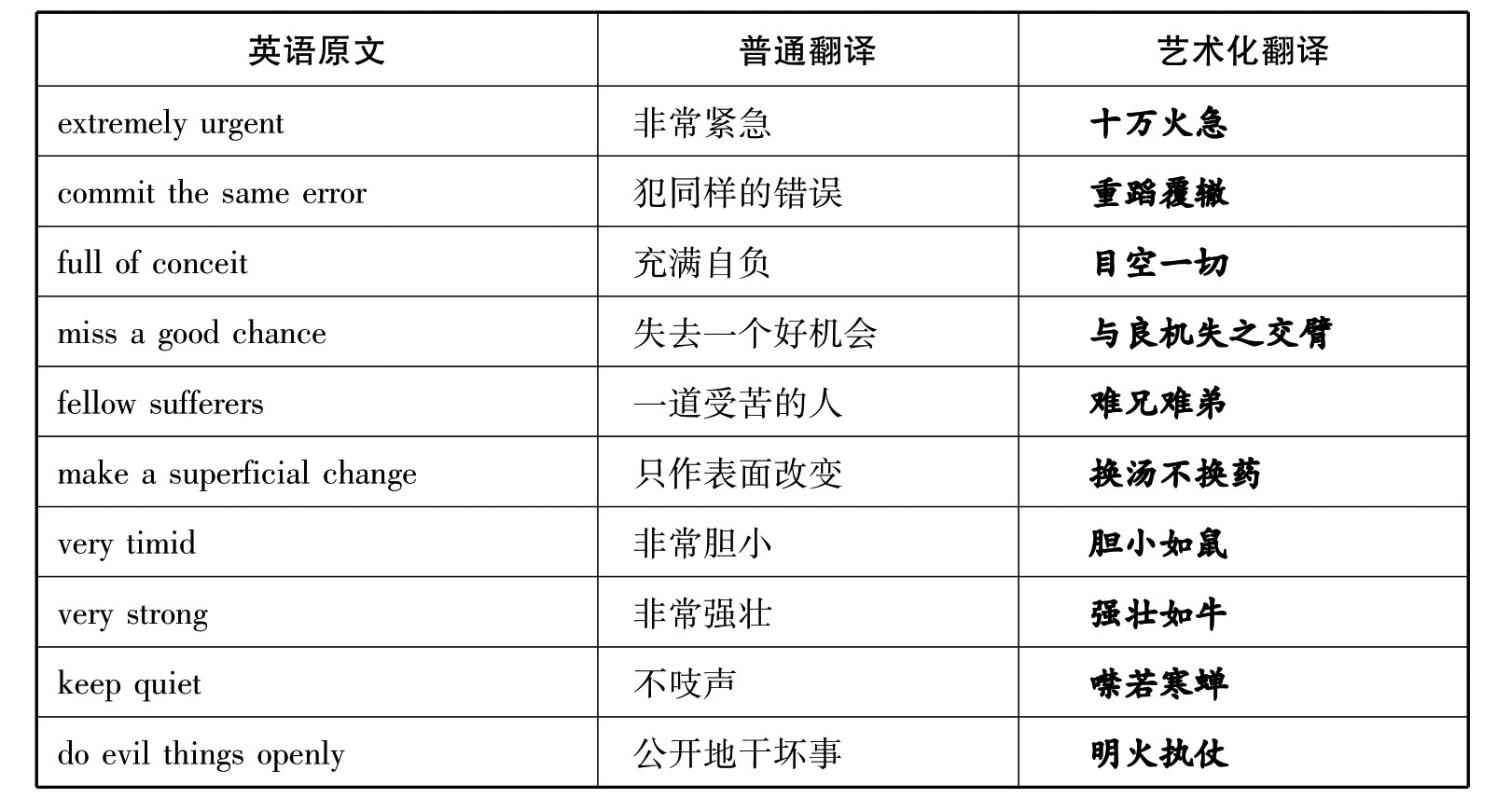二、翻译的艺术性
如果说科学讲求的是“真”,那么艺术讲求的就是“美”;翻译科学研究的结果是“对与错”的问题,那么经过艺术创造的译文就有一个“雅与俗”的问题。
许渊冲在他《翻译的艺术》一书中说:
忠实于原文内容,通顺的译文形式,发挥译文的优势,可以当作文学翻译的标准。翻译可以不发挥译文语言的优势,但发挥了译文语言优势的翻译却是更好的翻译。是否符合必要条件是个对错问题,是否符合充分条件却是个好坏问题。
“发挥译文语言优势”是评判译文艺术性的必要条件。好的译文无论是文学著作,还是政论文章;无论是散文诗歌,还是科普常识,都应该是译文读者喜闻乐见的东西,都应该给译文读者以美的享受,而不应该让读者在读了我们的译文之后仍有疑问或不解之处。在这里有必要援引美国作家Elwyn B.White对写作的一段论述:
Economical writing is efficient and aesthetically satisfying.While it makes a minimum demand on the energy and patience of readers,it returns to them a maximum of sharply compressed meaning.You should accept this as your basic responsibility as a writer:that you inflict no unnecessary words on your readers—just as a dentist inflicts no unnecessary pain,a lawyer no unnecessary risk.Economical writing avoids strain and at the same time promotes pleasure by producing a sense of form and right proportion,a sense of words that fit the ideas that they embody—with not a line of“deadwood”to dull the reader's attention,not an extra,useless phrase to clog the free flow of ideas,one following swiftly and clearly upon another.
(李观仪,2004:140)
这段话说的是写作,对翻译也同样适用。读好的译文,应该像观赏艺术品一样,是一种享受。译文读者不应该有任何心理负担,一个有责任心的译者没有权力要求读者做出什么努力才能看懂译文。
那么,汉英两种语言的优势何在?又美在哪里?下面分别对此进行分析。
先说汉语,“现代汉语之美,美在古朴典雅,美在简洁庄重。此美多源于对传统的承传,或曰文言也。”
(毛荣贵,2006:202)
请看下列译例:
例1:
Some kinds of plastics can be forced through machines which separate them into long,thin strings,called“fibers”,and these fibers can be made into cloth.
有些塑料可用机器制成细长的线,称为“纤维”,可织布。
【分析】英语句子必须使用三个被动结构才能使全句上下贯通,逻辑完整。汉语句子则没有必要用这些关联成分,句意自明;不用这些语法功能词,结构更紧凑,更为言简意赅。
例2:
Tell me and I'll forget;show me and I may remember;but involve me and I'll understand.
A.告诉我的事情,我会忘记;给我看的东西,我可能会记住;但让我一起干,我就会理解。
B.耳闻不如目睹;目睹不如笃行。
【分析】虽然译文A也能达意,但平铺直叙,缺少文采,读后让人兴趣索然。译文B既忠实于原文,又体现了中文的简洁、典雅之美。
例3:
Studies serve for delight,for ornament,and for ability.Their chief use for delight is in privateness and retiring;for ornament,is in discourse;and for ability,is in the judgment and disposition.
读书足以怡情,足以博彩,足以长才。其怡情也,最见于独处幽居之时;其博彩也,最见于高谈阔论之中;其长才也,最见于处世判事之际。
(毛荣贵 译)
【分析】英语原文已经很简练了,但仍不如汉语译文典雅、有文采,其中三个“足以”,三个“最见于”,不但没有给人以冗余之感,反而加强了语气,强调了人们对“开卷有益”的认识。其中的“怡情”“博彩”“长才”三词提高了叙述的书卷气。
例4:
虞美人
春花秋月何时了?往事知多少!
小楼昨夜又东风,故国不堪回首月明中。
雕栏玉砌应犹在,只是朱颜改。
问君能有几多愁?恰似一江春水向东流。
The Lost Land Recalled
—Tune“The Beautiful Lady Yu”
When will there be no more autumn moon and spring flowers
For me who had so many memorable hours?
My attic which last night in vernal wind did stand
Reminds me cruelly of the lost moonlit land.
Carved balustrades and marble steps must still be there,
But rosy faces cannot be as fair.
If you ask me how much my sorrow has increased,
Just see the over-brimming river flowing east!
(许渊冲 译)
【分析】这是南唐后主李煜追忆故国,抒发亡国之痛的绝世之作,充满了无限愁情。虽然许渊冲的译作很好地保持了原词的词韵,但是汉语原作所给人的那种凄美意境却无法再现。
另外,大量的双音节词和四音节词的运用使汉语有一种特有的均衡美和节奏美。由于这一倾向的影响,汉语音节匀称,词语和句式往往成双成对,对偶、对照、排比、反复和重叠成了中国人所喜闻乐见的修辞方式。
例5:
It was a day as fresh as grass growing up and clouds going over and butterflies coming down can make it.It was a day compounded from silences of bee and flower and ocean and land,which were not silences at all,but motions,stirs,flutters,risings,fallings,each in its own time and matchless rhythm.
绿草萋萋,白云冉冉,彩蝶翩翩,那日子是如此清新可爱;蜜蜂无言,春花不语,海波声歇,大地音寂,那日子又是如此静谧平和。然而,静并非真静,世间万物以其特有的节奏,或动,或摇,或震,或起,或伏。
【分析】原文中的silences of bee and flower and ocean and land译成“蜜蜂无言,春花不语,海波声歇,大地音寂”四音节词,silences译为四个不同的词:“无言”、“不语”、“声歇”、“音寂”,这样读起来更为生动,更有诗意,节奏感更强。
在英译汉时,不用四音节词或四字成语,只能达到通顺的效果,用了这类词,译文就有了节奏美,就有了文采。试比较下列词语的汉译:

续表

毫无疑问,四字成语的运用提高了译文的艺术性,使中国人读起来更感亲切。
那么,英语的艺术美又展现在哪里呢?英语之美,美在表达精当,叙述准确,条理分明。请看下列译例:
例6:
刚来北京那年,真是吃了不少苦头。还不错,遇见了一个大好人,就是外语学院的王教授。他可是我真正的好老师啊!没有他的指点和帮助,我今天还不知道在哪儿呢!
When I first came to Beijing,life wasn't smiling on me,but I had the good luck to meet a really good man,Professor Wang of a foreign language institute.He was my teacher in the true sense of the word.Without his advice and help,I wouldn't be where I am today.
【分析】汉语原句是个无主句,句中的“还不错”听起来也非常模糊,什么叫“还不错”?怎么个“不错”法?英语的I had the good luck就清楚多了,讲话人遇到王教授是因为“幸运”。在翻译“他可是我真正的好老师啊!”一句时,无论你用什么形容词,如really,truly,extremely,certainly,都不能译出讲话人的心情。一句惯用语in the true sense of the word就解决了问题。“没有他的指点和帮助,我今天还不知道在哪儿呢!”属虚拟语气,中国人一听便知,但在英译中,必须用语法手段明确表示出来:I wouldn't be where I am today。
例7:
从我的观察,他精神一好便什么都好,出些过错他反而安慰你,逗你开心。怕就怕他连续几夜睡不好觉,精神长期高度紧张,那时最容易发脾气。
As I observe,when he is in a good humor,he will find everything agreeable,even mistakes;he will talk to the offender kindly and playfully so as to make him forget his mistakes.But it is an entirely different story if he hasn't slept for several nights or when his nerves are on edge.That is when he easily becomes irritable.
【分析】原文里的“他精神一好便什么都好”一句,意思很模糊,英译为when he is in a good humor,he will find everything agreeable,意思就很清楚了:“他精神一好,就觉得事事顺心。”“出些过错他反而安慰你,逗你开心。”谁的过错?怎么逗人开心?英译文中交代得清清楚楚:he will talk to the offender kindly and playfully so as to make him forget his mistakes.
例8:
在许多北京人的记忆中,四合院是个令人快乐的所在,小院儿里住着几户人家,二十几个人。同院的孩子一起玩儿,一块儿长,就像一家人。虽然屋子里没有暖气,没有下水道,又没有洗手间,生活不太方便,可邻居们一块儿住着,出出进进地道声辛苦,日子过得也挺愉快。
The residential compound with houses around a courtyard,as many Beijingers recall,was a happy kind of place.There were often four to ten families with an average of 20 people sharing the courtyard complex.The children played together and grew up like one family.Inconveniences like the absence of central heating,indoor toilets and plumbing might make life somewhat hard,but the dwellers enjoyed sharing a place that way.They felt quite close to each other when they exchanged greetings everyday.
【分析】原文中的“洗手间”“日子过得也挺愉快”“出出进进地道声辛苦”都不甚明确,在英译文里必须分别用indoor toilets,the dwellers enjoyed sharing a place that way,They felt quite close to each other when they exchanged greetings everyday明确地翻译出来。
例9:
如今,北京的家庭平均人口呈下降趋势。70年代家庭平均人口是4人,80年代就变成3.5人了。到了1990年,人口普查显示出平均人口是3.2人。另外,越来越多的人希望同他们的父母或已婚子女分开来过。老舍笔下的“四世同堂”式的大家庭只能在小说中才能找到了。
Today families in Beijing are getting smaller.In the 70s the average size was four.A decade later it dropped to 3.5.The 1990 city census showed a further shrink to 3.2.Another reason for smaller families is that an increasing number of people now live in separate houses from their parents or married children.Big families as “four generations under one roof ”can only be found in print.
【分析】原文中的“另外”的意思不是很明确,所以必须译成Another reason for smaller families。这篇短文议论的主题是北京的家庭结构,不必介绍老舍先生,所以在译文里没有提及。“‘四世同堂’式的大家庭只能在小说中才能找到了”中的“小说”也不准确,所指单一,在回忆录、报告文学、散文等文体中仍会出现“四世同堂”这一说法,因此译文用in print对之。
总之,翻译中体现出的艺术性、创造性取决于是否“发挥译文语言优势”。成功的译文在内容达意的基础上要扬译文所长,避原文所短,真正达到理想的美学效果。
思考题
1.如果说翻译是一门科学,其科学性、规律性体现在哪里?
2.如果说翻译是一门艺术,如何发挥其艺术性?从哪个角度体现译文的艺术性?
免责声明:以上内容源自网络,版权归原作者所有,如有侵犯您的原创版权请告知,我们将尽快删除相关内容。

















